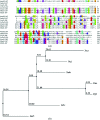Structure of the signal transduction protein TRAP (target of RNAIII-activating protein)
- PMID: 22750855
- PMCID: PMC3388912
- DOI: 10.1107/S1744309112020167
Structure of the signal transduction protein TRAP (target of RNAIII-activating protein)
Abstract
The crystal structure of the signal transduction protein TRAP is reported at 1.85 Å resolution. The structure of TRAP consists of a central eight-stranded β-barrel flanked asymmetrically by helices and is monomeric both in solution and in the crystal structure. A formate ion was found bound to TRAP identically in all four molecules in the asymmetric unit.
Figures






Similar articles
-
C-terminus of TRAP in Staphylococcus can enhance the activity of lysozyme and lysostaphin.Acta Biochim Biophys Sin (Shanghai). 2008 May;40(5):452-8. doi: 10.1111/j.1745-7270.2008.00415.x. Acta Biochim Biophys Sin (Shanghai). 2008. PMID: 18465031
-
Crystal structure of Bacillus subtilis anti-TRAP protein, an antagonist of TRAP/RNA interaction.Proc Natl Acad Sci U S A. 2005 Dec 6;102(49):17600-5. doi: 10.1073/pnas.0508728102. Epub 2005 Nov 23. Proc Natl Acad Sci U S A. 2005. PMID: 16306262 Free PMC article.
-
TROSY-NMR studies of the 91kDa TRAP protein reveal allosteric control of a gene regulatory protein by ligand-altered flexibility.J Mol Biol. 2002 Oct 25;323(3):463-73. doi: 10.1016/s0022-2836(02)00940-3. J Mol Biol. 2002. PMID: 12381302
-
Regulation of tryptophan biosynthesis: Trp-ing the TRAP or how Bacillus subtilis reinvented the wheel.Mol Microbiol. 1997 Oct;26(1):1-9. doi: 10.1046/j.1365-2958.1997.5541915.x. Mol Microbiol. 1997. PMID: 9383185 Review.
-
The FHA domain.FEBS Lett. 2002 Feb 20;513(1):58-66. doi: 10.1016/s0014-5793(01)03294-x. FEBS Lett. 2002. PMID: 11911881 Review.
Cited by
-
Witch Hazel Significantly Improves the Efficacy of Commercially Available Teat Dips.Pathogens. 2020 Feb 1;9(2):92. doi: 10.3390/pathogens9020092. Pathogens. 2020. PMID: 32024049 Free PMC article.
-
whISOBAXTM Inhibits Bacterial Pathogenesis and Enhances the Effect of Antibiotics.Antibiotics (Basel). 2020 May 19;9(5):264. doi: 10.3390/antibiotics9050264. Antibiotics (Basel). 2020. PMID: 32438609 Free PMC article.
-
The Effect of Tannin-Rich Witch Hazel on Growth of Probiotic Lactobacillus plantarum.Antibiotics (Basel). 2022 Mar 16;11(3):395. doi: 10.3390/antibiotics11030395. Antibiotics (Basel). 2022. PMID: 35326857 Free PMC article.
-
Heme catabolism in the causative agent of anthrax.Mol Microbiol. 2019 Aug;112(2):515-531. doi: 10.1111/mmi.14270. Epub 2019 May 27. Mol Microbiol. 2019. PMID: 31063630 Free PMC article.
-
Growth phenotype analysis of heme synthetic enzymes in a halophilic archaeon, Haloferax volcanii.PLoS One. 2017 Dec 28;12(12):e0189913. doi: 10.1371/journal.pone.0189913. eCollection 2017. PLoS One. 2017. PMID: 29284023 Free PMC article.
References
-
- Adams, P. D. et al. (2010). Acta Cryst. D66, 213–221. - PubMed
-
- Arnold, K., Bordoli, L., Kopp, J. & Schwede, T. (2006). Bioinformatics, 22, 195–201. - PubMed
-
- Balaban, N., Goldkorn, T., Gov, Y., Hirshberg, M., Koyfman, N., Matthews, H. R., Nhan, R. T., Singh, B. & Uziel, O. (2001). J. Biol. Chem. 276, 2658–2667. - PubMed
-
- Dauter, Z., Dauter, M. & Rajashankar, K. R. (2000). Acta Cryst. D56, 232–237. - PubMed
MeSH terms
Substances
Associated data
- Actions
LinkOut - more resources
Full Text Sources
Other Literature Sources

